How To Store Turnips To Stay Fresh Longer (4 Ways To Do It!)

Turnips are commonly recognized as being one of the most popular vegetables in Europe during the Middle Ages. Considering that people during that age didn’t exactly own refrigerators, it’s interesting to know how they stored their foods…and how we can store them even better. If you love eating turnips as much as we do, you’re going to love this neat little guide on turnip storage.
There are several ways to make turnips stay fresher for longer. Each method works for a specific part of the plant or a specific purpose. The best methods include:
- The Damp Towel Technique
- The Sand Technique
- Freezing Your Turnips
- In Your Garden
Turnips are pretty tasty treats to eat, but only if you have them fresh. With our handy guide, you’re going to be able to cut down on your turnip shopping bills with a little help.
How Long Do Turnips Last?
Turnips are a root vegetable, which tends to bode well for their longevity. Unlike radishes, turnips can last for several months when refrigerated. If you freeze them, they can keep for up to a year. Long-term storage can be even more extended, with some turnips being capable of lasting as long as 1.5 years.
Needless to say, it’s understandable why so many medieval villages relied on turnips for sustenance during winters. They keep for a long, long time. In fact, as you will see, turnips are one of the most durable vegetables you can buy.
Before You Begin: How To Pick Good Turnips
Much like with other vegetables (like radishes or green onion), choosing the right turnips will help you max out the shelf life you can get. Thankfully, figuring out which of these root vegetables are good is a cinch. Good turnips will have a fresh earthy smell, won’t have mold, and will look good.
If you’re not sure whether or not the turnip in question is good to eat, squeeze it. If it has a soft exterior or feels slimy, then it’s expired and should be thrown out. On a similar note, don’t eat a turnip that’s heavily discolored or that has a foul smell to it. On a similar note, you also should avoid turnips that look dry or cracked, since this can cause the turnip to rot faster or taste foul.
How To Store Turnips
While food always tasted the best immediately after harvesting, knowing how to properly store your turnips can help retain some of those lovely garden-fresh flavors. Plus, it can even prolong the length of time that the vegetables keep. Ideally, you want to store turnips in a cold, moist place that is as close to freezing as possible without actual freezing temperatures and approximately 95 percent relative humidity.
With this in mind, there are actually a few different ways you can go about storing turnips. Let’s take a look.
How to Store Turnips in Fridge – The Damp Towel Technique
If there is one thing that you probably will learn from reading about all the different ways to store vegetables, it’s that a lot of veggies need some dampness in order to stay at their optimal freshness. Turnips are part of this family. Here’s how to use this technique:
- Start off by washing and scrubbing your turnip thoroughly in cold water. If you want to keep the turnip longer than two weeks, skip this step.
- Wrap each turnip root in a damp towel, and place each root in its own plastic bag. Cover the green tips with another plastic bag.
- Store all the bagged turnips in one larger bag, and place it in your fridge. This will keep for a minimum of two weeks.
Note: You can also store turnip greens this way too. They also can be stored in a perforated plastic bag.
The Sand Technique
Are you a fan of food history? Well, this is very likely one of the few methods that might have been used in the days of yore. It also happens to be the most reliable way to make sure that your turnips last for a long, long time. Wondering how medieval peasants kept their food fresh? This might be a similar technique below.
Whether you don’t have anymore space in your fridge, or you’re simply looking for an alternative way to store your turnips, try this:
- Grab a box of sand, sawdust, or store-bought peat moss. Grab a spray bottle full of water and mist this sandbox down until everything is damp.
- Place the turnips top side down in the box, and add enough sand to lightly cover the bottoms. Spread them in a single layer, two inches apart. Make sure that you don’t have them touch, as this will harm the preservation process.
- Grab the box and place it in a place that is cool and away from light. Mist occasionally and check on the turnips from time to time. When choosing a place to store your turnips, it’s best to choose a place that is as close to freezing as possible. Usually, 37 to 42 degrees Fahrenheit is the “sweet spot.”
Note: We do not suggest this if you have a warm home, or if you don’t have a basement. This needs cool temperatures to survive. Moreover, you might want to put this box on a table to prevent critters from getting into it. If you have a serious pest problem, skip this option as it can taint the turnips.
Freezing Your Turnips
Freezing your turnips is another good choice, especially if you want long-term storage but don’t have a basement for your veggies. Here’s how you can freeze your turnips the right way:
- Begin by washing and peeling your turnip roots. Cut them into tiny cubes, maybe 1 to 1/2 inch in size. Remove and toss the greens.
- Bring a pot of water to a boil, then dump the cubes in. Keep them there for two minutes. While they’re boiling, grab a bowl and add ice water to it.
- Remove the cubes after their boiling session, and drop them in the ice bowl. This completes the blanching process and will make it easier for you to keep the flavor and texture of the turnips in check.
- Drain the water from the bowl with the cubes and remove any ice you had in there. Place the cubes from the bowl into a large jar, then place it in the freezer. This can give you “fresh” turnips for about a year.
Note: We strongly suggest this method if you use turnips in soups or other blended recipes. The small cubes are ideal for blender use and can be used right out of the freezer.
In Your Garden
Did you grow a ton of turnips? Like, way more than you can eat in a month or so? Congratulations, you’re a better gardener than I am. There’s some good news here, too. Assuming that you have cool to cold weather, you can simply leave the turnips in the ground, with the tops covered by straw, or to protect them from the elements.
One thing that you need to be aware of if you choose this option is that outdoor storage means outdoor problems. If you have a serious flood, you will lose your turnips. Moreover, if you have a lot of deer, chances are that they will try to get those turnips at any cost. That means you will have to be super vigilant about protecting your turnips from them.
Note: This method is best used in areas that do not have many hard freezes, or extreme heatwaves. If your area tends to have seasonal problems such as blight or specific pests, try to store your freshly harvested turnips indoors.
Don’t Forget the Greens
Just like many other root vegetables, turnips have edible greens. When you remove the tops of your turnips, don’t throw them out. Instead, store the greens in the fridge, in a similar way that you would the roots themselves. Wrap the greens in a damp towel or paper towel and place them in an airtight container in your refrigerator. Turnip greens can make a delicious edition to soups, stir-fries, and salads.
How Do You Tell If Turnips Are Bad?
There are a couple of different ways to tell that your turnips have gone bad and are no longer safe for consumption. Like every other vegetable, turnips will go bad when aging, as a result of improper storage, and when not attended to properly. That said, here are the most common indications that your turnips are bad:
- Discoloration: If you notice the turnips have an appearance that is off or the color has changed from its original color, toss them out. You may also start to detect the presence of mold when a turnip goes bad.
- Bad odor: Aside from appearance, the easiest way to tell if a turnip is bad is by smelling it. If it no longer has that fresh, earthy odor, the turnip is spoiled and should be throwed out.
- Texture changes: When the texture of the turnip becomes soft, stringy, or even damp, this is a sign that it has gone bad.
What Happens If You Eat Bad Turnips?
Let’s say that you didn’t store the turnips you bought well and now they’re a little fuzzy. Can you still salvage them or eat them safely? The truth is that you probably shouldn’t. If you have a mold allergy, you will probably have a pretty bad reaction since mold is a pervasive problem in most turnips when they start to rot. This can cause rashes, vomiting, stomach aches, and more.
Another major problem that you might have is the flavor. Turnips that are bad will taste awful, and no amount of spice or cooking will fix it. The only way to get the deliciousness that is a fresh turnip is to toss the rotten one out and buy some new ones. Sorry!
Related Questions
How long can you store turnips?
How long you store your turnips will depend on the method used. Turnips can be stored in the refrigerator for two weeks, while they’ll last eight to 10, and sometimes even 12 months in the freezer.
Are turnips safe to reheat?
Contrary to popular belief, turnips are not safe to reheat once they have been cooked. This is because they contain high levels of nitrates that can become somewhat dangerous if they are reheated.Eating excessive nitrates can be linked to “blue baby syndrome” or methemoglobinemia, which can make it difficult for people to carry oxygen in their blood cells. In some cases, it can also cause complications in pregnant women. Some studies also suggest that nitrate consumption can cause cancer.

Ossiana Tepfenhart is an expert writer, focusing on interior design and general home tips. Writing is her life, and it's what she does best. Her interests include art and real estate investments.
More by Ossiana Tepfenhart














![How Much Weight Can a 4×4 Support Horizontally? [It Depends!]](https://cdn-fastly.upgradedhome.com/media/2023/07/31/9070333/how-much-weight-can-a-44-support-horizontally-it-depends.jpg?size=350x220)












